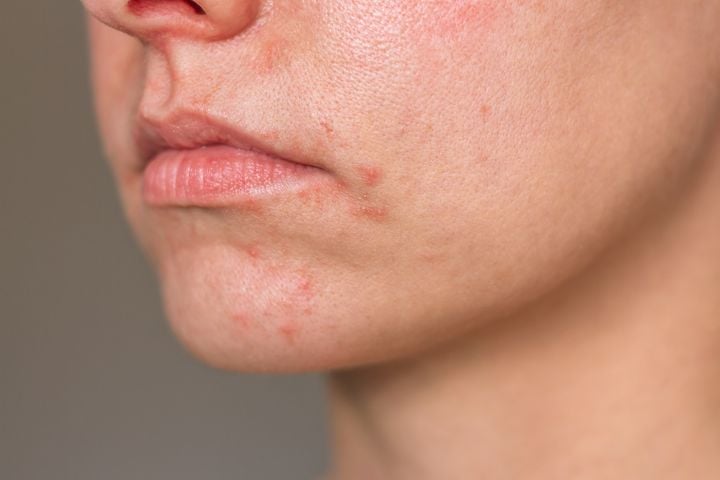Health
Unpacking Perioral Dermatitis: Stress or Product Overload?

The rise in cases of perioral dermatitis, marked by flare-ups around the mouth, nose, and eyes, has prompted concerns among dermatologists and skin specialists. This skin condition, which leads to red, bumpy patches, has become increasingly common, leaving many individuals seeking answers and effective treatments.
Understanding perioral dermatitis requires a look at its underlying causes. According to Dr. Sarah Johnson, a dermatologist based in London, multiple factors contribute to the condition. While stress has been identified as a significant trigger, the overuse of skin care products can also exacerbate symptoms. In recent discussions, experts noted that many people may not realize that using too many products can disrupt the skin’s natural barrier, leading to irritation.
Identifying Triggers and Symptoms
Perioral dermatitis is characterized by small, red, and sometimes itchy bumps that typically appear around the mouth and nose. Patients often report feeling self-conscious due to the visibility of the rash, which can be persistent and challenging to manage. Dr. Emily Clarke, a dermatologist in Sydney, emphasizes that environmental factors, hormonal changes, and the use of topical steroids can also play a role in the onset of this condition.
Skin irritation linked to perioral dermatitis is often mistaken for acne or eczema, leading to confusion in treatment approaches. Individuals experiencing these symptoms should consult a qualified skin expert for a proper diagnosis and treatment plan. Dr. Clarke recommends that patients keep a detailed record of their skin care routine and any changes in their lifestyle to help identify potential triggers.
Effective Treatment Strategies
Treating perioral dermatitis typically involves simplifying one’s skin care regimen. Experts suggest reducing the number of products used on the face, particularly those containing fragrances or harsh ingredients. According to a study published in the Journal of Dermatological Treatment, patients who discontinued their use of topical steroids reported significant improvements within a few weeks.
In addition to modifying skin care routines, dermatologists often prescribe topical or oral antibiotics for more severe cases. These medications can help reduce inflammation and clear up the rash effectively. Dr. Johnson highlights that patience is crucial, as it can take several weeks to see noticeable improvements.
Stress management is another vital component in treating perioral dermatitis. Techniques such as mindfulness, yoga, and regular exercise can help mitigate stress levels, potentially reducing the frequency and severity of flare-ups.
In conclusion, perioral dermatitis is a multifaceted condition that can arise from a combination of stress and the excessive use of skin care products. Seeking advice from experienced dermatologists and adopting a simpler skin care routine can provide relief. As awareness grows, individuals experiencing these symptoms are encouraged to consult skin experts for tailored treatment options.
-

 Entertainment2 months ago
Entertainment2 months agoAnn Ming Reflects on ITV’s ‘I Fought the Law’ Drama
-

 Entertainment3 months ago
Entertainment3 months agoKate Garraway Sells £2 Million Home Amid Financial Struggles
-

 Health2 months ago
Health2 months agoKatie Price Faces New Health Concerns After Cancer Symptoms Resurface
-

 Entertainment2 months ago
Entertainment2 months agoCoronation Street’s Carl Webster Faces Trouble with New Affairs
-

 Entertainment2 months ago
Entertainment2 months agoWhere is Tinder Swindler Simon Leviev? Latest Updates Revealed
-

 Entertainment3 months ago
Entertainment3 months agoKim Cattrall Posts Cryptic Message After HBO’s Sequel Cancellation
-

 Entertainment1 month ago
Entertainment1 month agoOlivia Attwood Opens Up About Fallout with Former Best Friend
-

 Entertainment2 months ago
Entertainment2 months agoMasterChef Faces Turmoil as Tom Kerridge Withdraws from Hosting Role
-

 Entertainment3 months ago
Entertainment3 months agoSpeculation Surrounds Home and Away as Cast Departures Mount
-

 World2 months ago
World2 months agoCole Palmer’s Mysterious Message to Kobbie Mainoo Sparks Speculation
-

 Entertainment2 months ago
Entertainment2 months agoITV’s I Fought the Law: Unraveling the True Story Behind the Drama
-

 Entertainment3 months ago
Entertainment3 months agoMarkiplier Addresses AI Controversy During Livestream Response





















